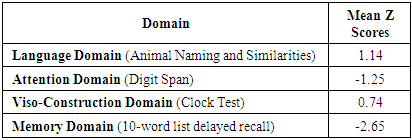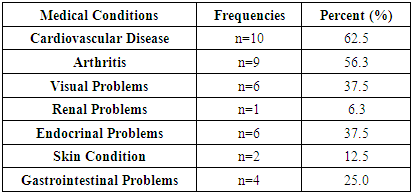-
Paper Information
- Paper Submission
-
Journal Information
- About This Journal
- Editorial Board
- Current Issue
- Archive
- Author Guidelines
- Contact Us
Journal of Health Science
p-ISSN: 2166-5966 e-ISSN: 2166-5990
2019; 9(2): 19-21
doi:10.5923/j.health.20190902.01

Vieques, Puerto Rico: An Island within an Island, a Descriptive Study of Cognitive Performance in a Sample of People 60 Years and Older
José Rodríguez Gómez1, 2, Rosa Janet Rodríguez1, 3, Lizzette Roman-Marrero1, Maribella Gonzalez1, Estefanía Texidor Vega1
1Carlos Albizu University, San Juan PR
2University of Puerto Rico, Medical Sciences Campus, San Juan, PR
3University of Puerto Rico, Rio Piedras Campus, Facultad de Ciencias Sociales, Apartado Postal 23301 Avenida Barbosa Avenida Ponce de León, San Juan PR
Correspondence to: José Rodríguez Gómez, Carlos Albizu University, San Juan PR.
| Email: |  |
Copyright © 2019 The Author(s). Published by Scientific & Academic Publishing.
This work is licensed under the Creative Commons Attribution International License (CC BY).
http://creativecommons.org/licenses/by/4.0/

Introduction: Dementia, as major psychopathology, is the most prevalent condition in elderlies in Puerto Rico (PR) most suffering from Alzheimer (AD) which currently is the fourth cause of death among Puerto Ricans. Cognitive decline is the most common characteristic of Alzheimer’s Disease that leads to dementia. Despite advances in detection and early treatment strategies, many individuals with dementia do not receive proper assessments and available therapies. Vieques is one of the offshore islands located on the east coast of PR mainland. It has the singularity of being one of the two municipalities that are separated from the main land, via ocean, which results in the difficulty to access adequate health care services. Method: The purpose of this study was to evaluate a group of elderlies from Vieques Island (62 to 89 years, n=15), through valid neuropsychological screening instruments for Puerto Ricans. The instruments were composed of a screening battery that included the 10-word list CERAD (instruments developed by the Consortium to establish a Registry for Alzheimer’s Disease), MMSE (Mini-Mental Status Evaluation), EIWA-III (specifically, digit span and similarities subtest which the objective is to evaluate memory, concentration, and abstract thinking), and the Tuokkos’s test (clock drawing to evaluate visual-constructional skills). Results: More than half of the sample presented criteria for a neurocognitive disorder. NIA criteria were used. According to the sample, 66% was classified as Dementia Amnestic Type n=10, 13% (n=2) not demented and 20% (n=3) met MCI criteria. Conclusions: Intervention approaches need to be implemented toward prevention and the avoidance of functional disability in Vieques older population considering the serious implications they may develop for the expression of Alzheimer’s Dementia that present this pioneering research.
Keywords: Alzheimer, Elderly, Vieques, Puerto Rico
Cite this paper: José Rodríguez Gómez, Rosa Janet Rodríguez, Lizzette Roman-Marrero, Maribella Gonzalez, Estefanía Texidor Vega, Vieques, Puerto Rico: An Island within an Island, a Descriptive Study of Cognitive Performance in a Sample of People 60 Years and Older, Journal of Health Science, Vol. 9 No. 2, 2019, pp. 19-21. doi: 10.5923/j.health.20190902.01.
1. Introduction
- It is estimated that around 5.5 million people in the United States are affected by Alzheimer’s Disease (AD). [1] In addition, Alzheimer’s Disease is the fourth cause of death in Puerto Rican society. [2] As major psychopathology, dementia, indeed is the most prevalent condition in elderlies in Puerto Rico (PR). [2] For instance, Vieques is one of the offshore islands located on the east coast of PR mainland. It has the singularity of being one of the two municipalities that are separated from the mainland via water, which results in the difficulty to access adequate health care services. The issue of an aging population and the decline in cognitive performance is particularly relevant in the Island of Vieques since it is estimated that 8,364 live in the Island of Vieques and a 22.3% are people older than 65 years of age. [3]Dementia is defined as a significant decline affecting attention, executive functions, memory and learning, perceptual and motor ability, and social cognition. [4] “Dementia is a group of symptoms associated with a decline in memory or other thinking skills severe enough to reduce a person's ability to perform everyday activities caused by damage to brain cells…. Alzheimer disease is considered to be the most common form of dementia”, and is highly associated with memory loss, however, dementia can be emphasized in other functions. [5] There are six types of dementia: cortical dementia, subcortical dementia, progressive dementia, primary dementia, secondary dementia, and vascular dementia. Alzheimer’s is the most prevalent, is associated to decrease of cognitive performance like loss of memory represented in loss of language and recent events, disorientation, lack of social skills, aphasia and agnosia. [6] Despite advances in detection and early treatment strategies, many individuals with dementia do not receive proper assessments and available therapies. A description of the sample can help with the prevention of the disease and the implications in public health and society. [7,8]The study objective was to evaluate a group of elderlies (62 to 89 years, n=15), in the island of Vieques through valid neuropsychological screening instruments for Puerto Ricans. The instruments were composed of a screening battery that included the 10-word list CERAD (instruments developed by the Consortium to Establish a Registry for Alzheimer’s Disease), MMSE (Mini-Mental Status Evaluation), EIWA-III (specifically, digit span and similarities subtest which the objective is to evaluate memory, concentration, and abstract thinking), and the Tuokkos’s test (clock drawing to evaluate visual-constructional skills). The inability to have, at this time, a curative treatment addresses our research efforts to early identification of the condition. We aim to help diminish the mortality and morbidity rates.
2. Method
- Design and sample description:A descriptive ex-post-facto design was conducted via face to face interview. The total sample size consisted of 15 subjects by availability (females n=8 and males n=7) recruited from residential federal funded Project homes for the elderly known as “Égidas” and Elderly Care Centers municipal government- funded projects in Vieques. The age range was 62 to 89 years (M=72.82, SD=7.89) and the average education was 1 to 18 years (M=9.25).
3. Results
- A concise cognitive screening/assessment valid battery was administered to each participant. Researchers maintained confidentiality and uphold their ethical standards of research with human subjects at all times as required by the Institutional Review Board (IRB) of the University and the Puerto Rico Psychological Association. The following tests were administered to the participants as a part of the Screening/Assessment Battery; 10-word list subtest of the CERAD, the MMSE (Mini-Mental Status Evaluation), the EIWA-III (specifically the digit span and similarities subtest, which objective is to evaluate working memory, concentration, and abstract thinking), and the Tuokko Clock Test, which objective is to assess visual constructive ability through the subject’s drawing of a clock. The participants reported no prior diagnosis or treatment received for neurocognitive disorders. The mean score obtained on the MMSE was 22.6 and 43.8% (n=7) obtained a score < 24 on the MMSE (See Table 1, 2, and 3). All tests have adequate psychometrics values for Puerto Rican samples (i.e., Cronbach’s alpha >.70 according to Kline, 2000). [9]
|
|
|
4. Discussion
- More than half of the sample presented criteria of neurocognitive disorders that have not been previously identified. Using the NIA criteria for Neurocognitive disorders, 66.6% (n=10) Amnestic Type were identified, 20.0% (n=3) were identified as not demented, and 13.3%, (n=2) using the MCI criteria. Given the particular geographical characteristics of the island of Vieques, healthcare services are limited with the extreme repercussions to the well-being of the elderly, especially those who have not obtained adequate identification of neurocognitive disorders. Furthermore, intervention approaches can be implemented toward prevention and the avoidance of functional disability in Vieques older population considering the serious implications they may develop. This interventions included, but are not limited, to deal and prevent dietary risk factors for the development of Alzheimer Dementia (i.e., Hypercholesterolemia); avoiding head trauma, obesity, diabetes, oxidative cellular damage via radiation (the main factor in Vieques Island due to the USA Marine bombing practice), depression and hypertension, within others well- known factors that may be linked to the develop of AD. [5-7] While study findings are alarming, a few aspects should be considered in evaluating our findings. Although our sample was small, Vieques Island is a small island with almost 9,000 people and of those, approximately 1,000 are considered over 65 years old according to the Census Bureau. Since the subjects were evaluated from the Égidas and a small amount provided consent for the investigation, limits the quantity for our investigation. On the other hand, all clinical testing performed for this investigation considers cognitive performance for implications in Alzheimer’s Disease development.
 Abstract
Abstract Reference
Reference Full-Text PDF
Full-Text PDF Full-text HTML
Full-text HTML

